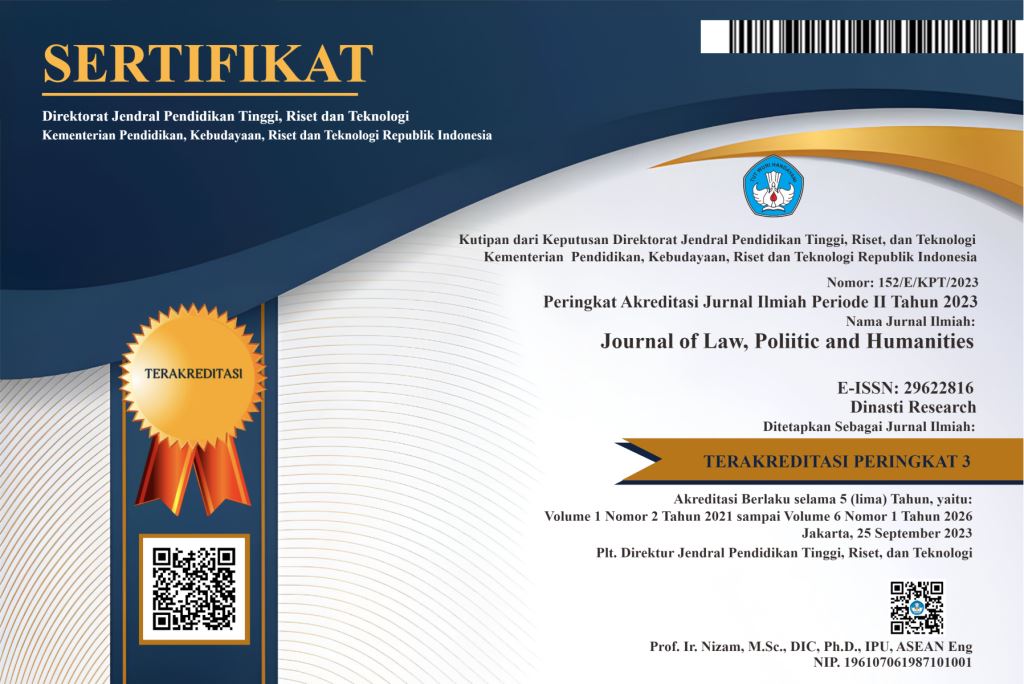Bankruptcy of Individual Debtors Regarding Joint Assets of Husband and Wife
DOI:
https://doi.org/10.38035/jlph.v5i2.797Keywords:
Bankruptcy, Joint Property, Marriage AgreementAbstract
Marriage is a physical and spiritual bond between a man and a woman as husband and wife with the aim of forming a happy and eternal family or household based on the Almighty Godhead. The existence of this marriage results in the union of the husband's assets with the wife's assets, which is usually known as joint assets. However, this can be waived if there is a marriage agreement before the marriage takes place. The regulation of the concept of joint property in a husband and wife marriage experiencing bankruptcy is divided into two, namely for husband and wife who are married with a marriage agreement and for husband and wife who are married with a union of assets. For bankruptcy resolution, if joint assets are insufficient to pay debts, it must be proven that the debt is a personal debt or a joint debt.
References
Fred B.G. Tumbuan, Principles of Law on Bankruptcy as amended by PERPU No.1/1998.
Gunawan Wijaya, Bankruptcy and the Wealth of Husband and Wife, Bening Kliping, Bandung, 2002.
Hilman Hadikusuma, Indonesian Marriage Law according to Legislation, Customary Law, Religious Law, Mandar Maju, Bandung, 2003.
Imran Nating, The Role and Responsibilities of the Curator in the Management and Settlement of Bankruptcy Assets, RajaGrafindo Persada, Jakarta, 2004.
Isis Ikhwansyah, et al. Legal Analysis of Disputes and Family Law and Marital Property, Keni Media, Bandung, 2012.
Jerry Hoff, Bankruptcy Law in Indonesia (Indonesian Bankruptcy Law), translated by Kartini Muljadi, Tatanusa, Jakarta, 2000.
Moch. Isnaini, Indonesian Marriage Law, Surabaya, Refika Aditama, 2016.
Muljadi, Kartini, and Gunawan Widjaja, Guidelines for Handling Bankruptcy Cases, Jakarta, Rajawali Press.
Soerjono Soekanto, Indonesian Customary Law, RajaFrafindo Persada, Jakarta, 2002.
Subekti, Principles of Civil Law, Jakarta, Intermasa, 1994.
Sumarti Hartono, Introduction to Bankruptcy Law and Postponement of Payments, Liberti, Yogyakarta.
Surojo Wignojudipro, Introduction and Basics of Customary Law, Jakarta, Mount Agung, 1968.
Sutan Remy Sjahdeini, Bankruptcy Law Understanding Law No. 37 of 2004 concerning Bankruptcy and PKPU, Pustaka Utama Grafiti, Jakarta, 2010.
Zainal Asikin, Bankruptcy Law and Postponement of Payments in Indonesia, Raja Grafindo Persada, Jakarta, 2001.
Bankruptcy Regulation
Civil Code
Law No.37 of 2004 concerning Bankruptcy and Postponement of Debt Payment Obligations
Law No.16 of 2019 on Amendments to Law No.1 of 1974 on Marriage
Compilation of Islamic Law
Ardi Hanum Bratakusuma, et al. Legal Position of Joint Property of Husband and Wife After Bankruptcy Decision (Study of PT. GPF Decision), Diponegoro Law Review, Volume 5 Number 2 of 2016
Adela Logika, The Effects of Husband's Bankruptcy Law on Joint Assets Based on Decision Number 510/PDT.G/2019/PN.JKT.SEL, Pakuan Law Review, Volume 07 Number 02 July-December 2021
Evi Djuniarti, Joint Property Law Viewed from the Perspective of the Marriage Law and Civil Code, Journal of Legal Research, Vo.17 No.4, 2017.
I Gede Krisna, The Position of Marital Assets as Bankruptcy Assets of Religiously Divorced Husbands and Wives, Jurnal Kertha Semaya, Vol.9, No.4, 2021.
Putu Indri Sri Giyanthi, Legal Status of Marital Assets in the Event of Husband/Wife Bankruptcy Without a Marriage Agreement, Journal of Legal Preferences, Vol.3 No.1, Maret 2022.
Downloads
Published
How to Cite
Issue
Section
License
Copyright (c) 2024 Shafira Hijriya, Misnar Sham

This work is licensed under a Creative Commons Attribution 4.0 International License.
Authors who publish their manuscripts in this journal agree to the following conditions:
- The copyright on each article belongs to the author(s).
- The author acknowledges that the Journal of Law, Poliitic and Humanities (JLPH) has the right to be the first to publish with a Creative Commons Attribution 4.0 International license (Attribution 4.0 International (CC BY 4.0).
- Authors can submit articles separately, arrange for the non-exclusive distribution of manuscripts that have been published in this journal into other versions (e.g., sent to the author's institutional repository, publication into books, etc.), by acknowledging that the manuscript has been published for the first time in the Journal of Law, Poliitic and Humanities (JLPH).


























